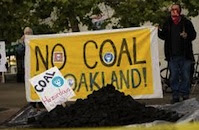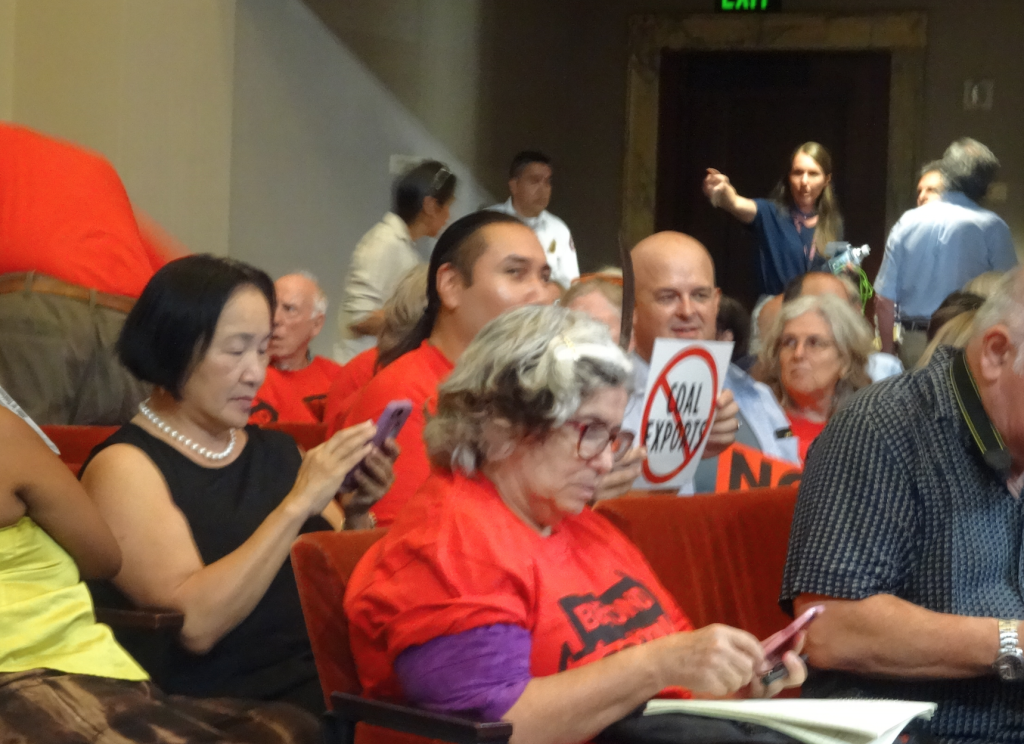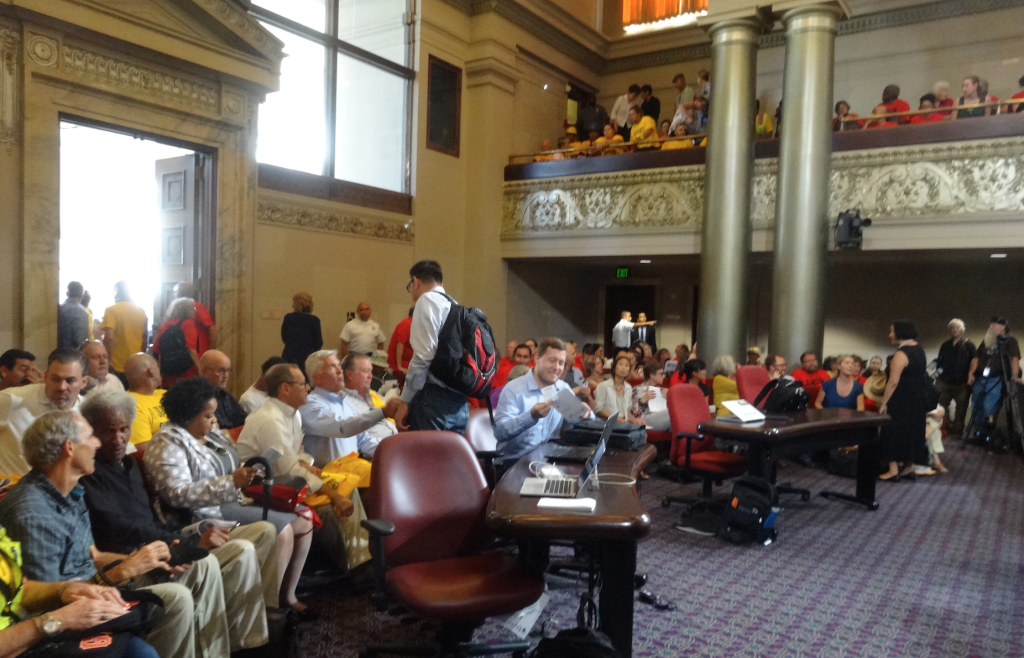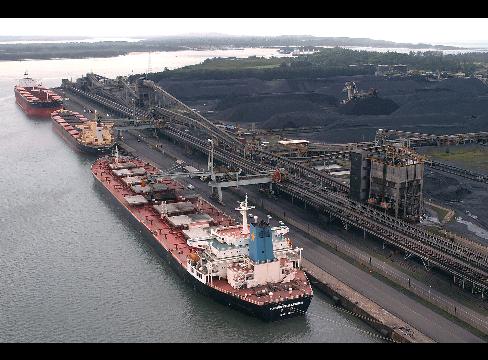The Coal Export Wars Reach Oakland
In seeking an alternative route to Asian markets, coal’s path from Utah to China via Oakland hits a snag
Expanded west coast infrastructure to support the export of western U.S. coal to Asian markets has long been part of the business plans for some of the nation’s largest coal producers. However, attempts by Powder River Basin coal interests to construct or expand coal export terminals in Washington and Oregon in recent years have been dealt fairly high profile setbacks by local officials under pressure from citizen activists.

The City of Oakland is now in the sights of at least one Utah coal producer seeking to develop a rail-to-ship export terminal that will handle up to nine million tons of Utah coal per year, delivered by as many as a dozen 100-car coal trains traveling through the city per week. If Monday’s special public hearing convened by Oakland City Council is any indication, the citizen activists of Oakland are every bit as aroused by the proposal as their Pacific Northwest brethren were.
From Utah to Oakland
There is an interesting backstory to how four Utah counties came to contribute $53 million to the construction of the Oakland Bulk and Oversize Terminal (OBOT) in order to assure that coal produced in those counties has access to the Asian export route. The connection between Utah coal and the OBOT was first revealed by the Richfield Reaper, a local Utah newspaper, in April of this year; the backstory has been fleshed out by Darwin BondGraham of the East Bay Express, who has written a series of well-researched articles detailing plans to use Oakland as a shipping hub for Utah coal.
The investigative reporting focused on an entity called Bowie Resource Partners, a Kentucky-based coal company that purportedly wants to massively expand its coal mining operations in Utah. In 2013, Bowie purchased the Sufco mine in Utah from Arch Coal. Its business plan at the time recognized the importance of the Oakland terminal to expanded Utah coal operations.
In purchasing Sufco (a top-producing Utah mine), Bowie also gained access to Greens Hollow Tract, a vast coal deposit accessible through the Sufco mine. Greens Hollow Tract is buried under the Fishlake and Manti-La Sal National Forests in Utah. U.S. Forest Service and BLM had previously leased the Greens Hollow Tract to Bowie, a decision that is currently being challenged, quite passionately it appears, by environmental groups.
The Richfield Reaper reported that, in April, the Utah Permanent Community Impact Fund Board (CIB), a special state agency that makes grants to rural Utah counties for sewers, fire stations, and other municipal improvements, quietly approved an unusual $53 million low-interest loan to four rural Utah counties. Per the report, this money was to be contributed to construction of the OBOT in exchange for 49% of the terminal’s shipping capacity, assuring that those counties could use it to export their coal. There are apparently some Utah residents and officials who believe that the CIB has been hijacked to illegally subsidize the fossil fuel industry.
By “Bulk Commodity,” You Meant Coal

The OBOT is part of a larger redevelopment project at the former Oakland Army Base, financed with a combination of public and private funds. The improvements for the OBOT part of the project will cost an estimated $250 million. The developer is an entity called California Capital and Investment Group (CCIG), headed by Phil Tagami, a prominent Bay area developer. The long-term lessee of the terminal would be a company called Terminal Logistics Solutions, or TLS.
The intrigue arises because, apparently, no one ever informed City officials that coal would be one of the primary products that would pass through the OBOT. In fact, Mr. Tagami explicitly stated in a December 2013 newsletter that CCIG “has no interest or involvement in the pursuit of coal-related operations at the former Oakland Army Base.”
The former mayor of Oakland, Jean Quan, has explained both at the hearing and elsewhere that the City’s approval process would have been much different had CCIG identified coal as a product. After news of the Utah coal connection broke, internal CCIG communications show the developer strategizing on how to downplay the inclusion of coal. That coal would be one of the exports from the OBOT was not formally confirmed by the developer until a July 2015 letter to the current Oakland Mayor. Through environmental reviews and contract negotiations and public funding processes stretching back several years, City officials claim to have never been advised that coal would be part of the product mix.

Battle Lines Drawn
Opposition to the proposed coal exports developed quickly, beginning with a protest outside of Mr. Tagami’s office building on May 14. An anti-terminal protest in Oakland in July attracted several hundred demonstrators. Shortly after, the Oakland City Council scheduled Monday’s special public hearing, to take testimony or comments on three issues:
— the health, safety and/or other impacts from transporting, handling and exporting of coal through, in and from Oakland;
— the adequacy of existing regulations; and
— the City’s ability to regulate the transportation and handling of such goods
Opponents of the OBOT were out in full force at Monday’s public hearing, which was attended by several members of Students for Economic and Environmental Justice (SEEJ), a Berkeley Law student group. At the entrance to the City Council building, numerous environmental groups sought signatures or passed out materials. Among the non-profit organizations whose presence was visible were Earthjustice, the Sierra Club, West Oakland Environmental Indicators Project, the Center for Biological Diversity, 350.org Bay Area, and the Union of Concerned Scientists.
This is not to say there was no support for the terminal at the hearing. Yellow “I Support Oakland Jobs” t-shirts, presumably worn by terminal supporters, competed with red “Beyond Coal Exports” shirts. But, while the Council President’s decision to alternate comments between opponents and supporters of the terminal gave the appearance of relative equality between the two armies, supporters of the terminal reportedly ran out of speakers about half way through the six-hour hearing.

In all, nearly 700 people signed up to speak at the hearing, and the Council chamber filled well before the 4:00 start time. Our group, watching via video feed from one of at least two crowded overflow rooms, did not make it through the entire six hours. The comments we did see were impressive in their depth and detail, often presented by highly credentialed experts from industry, local government or academia.
Opponents’ concerns ranged from the local effects of coal dust to the global effects of climate change. Many commenters noted that the West Oakland neighborhood surrounding the site is already highly polluted, at least in part because of large truck activity associated with the existing port, and a couple speakers were able to tie the neighborhood’s air quality to the relatively poor health statistics associated with local residents. In addition, concerns were raised over water contamination during transit near several crucial water supplies; water use to tamp down coal dust during handling and storage; increased noise and traffic; contaminants from coal combustion in China drifting back across the Pacific; and the localized effects of climate-change-induced sea level rise, extended heat waves, drought and extreme weather events.
Supporters of the terminal tended to focus either on the economic and jobs benefits of the project, or on the state-of-the-art practices that TLS will employ in its handling of the coal. Most of the supporters of the OBOT who actually spoke had some connection to the project, as many yellow t-shirt wearers ceded their time to these presumably more knowledgeable orators.
Industry’s West Coast Vision
The Oakland battle is taking shape at a time when the U.S. coal industry desperately wants to increase its presence in China and India. Coal consumption in the United States has been declining in recent years due to the abundance of cheap natural gas, the growth of renewables, and additional environmental regulation. It became apparent in the 2009-2010 time frame that the coal industry would seek to make up for the loss of U.S. demand by increasing exports. This worked for a couple years, as exports reached their highest levels ever in 2012. Exports have been declining, relatively rapidly, since that 2012 peak.

While there has been decreased demand both domestically and in our primary export market (Europe), demand for coal globally continues to grow, fueled largely by China’s insatiable appetite, and will continue to do so into the foreseeable future. While some U.S. coal is exported to Japan and South Korea, it is not a major player in Asia despite the relative cheapness of western U.S. coal; the lack of export terminal capacity is a primary reason why. Proposals over the past several years to construct or expand port terminals in Oregon and Washington in order to grow exports to China and India have been defeated or stalled at nearly every turn, primarily due to concerns about both local environmental impacts and global climate change.
Is It Too Late To Stop The Terminal?
It would not be surprising if many Oakland City Council members share the concerns of the OBOT opponents. In February of 2014, Oakland port commissioners rejected a proposal for a bulk coal export facility at the Port of Oakland’s Charles P. Howard Terminal after vigorous public opposition. In June of 2014, Oakland City Council adopted a “Resolution Opposing the Transportation of Hazardous Fossil Fuel Materials, Including Crude Oil, Coal, and Petroleum Coke, through the City of Oakland.” The Resolution does not purport to prohibit the transport of these items, but it does (a) make clear that Council opposes using existing rail lines to transport such items, (b) warn that the City will enforce all public health and safety standards, and (c) declare the City’s intention to more actively regulate such activities.
City officials are clearly struggling to discern their authority to control, regulate or ban the transport and export of coal. The Agenda Report prepared by City Council staff in advance of the public hearing focuses on the Development Agreement between the City and CCIG; according to the report, that agreement “vested the rights to develop” the terminal in CCIG, subject only to a narrow exception for certain later-enacted health and safety regulations. The Agenda Report also demonstrates concern over the City’s authority in light of the the federal government’s power over rail transport.
Several speakers at the hearing noted that the ill health effects associated with exposure to coal dust during transport and handling are well-documented. Proponents contend that such concerns will be addressed by covering the rail cars and building storage domes at the port. CCIG also points out that it has already received state environmental approval under the California Environmental Quality Act (CEQA). Many speakers noted, however, that the environmental impact report on which the CEQA approval is based was actually 13 years old, that coal was never mentioned as a commodity, and that the CEQA Addendum that TLS submitted in 2012 was not opened up to the public hearing process.
What’s next?
Construction of the OBOT is supposed to begin later this year and be completed in 2017. The stated purpose for Monday’s public hearing was information gathering, and there has been no indication of imminent City Council action. Mr. Tagami has made statements in the past indicating that CCIG will not stand by idly if the City tries to block the coal exports. The eyes of local residents, industry and activists nationwide are on Oakland City Council as it considers whether it has the authority to stop Utah coal from passing through west Oakland to market and, if so, how to exercise that authority.
UPDATE September 23, 2015: Minutes from the September 21 public hearing can be accessed here. At the conclusion of the hearing, Council voted to keep the public hearing open and continue to receive information through October 5, and to be prepared to make a recommendation that can be voted on by December 8. Among the specifically-listed options that will be considered are a ban on coal, a temporary moratorium, and a strict regulatory scheme.
Reader Comments
One Reply to “The Coal Export Wars Reach Oakland”
Comments are closed.








Great article, definitely a legit concern, is there any way to cover the train cars to insure that citizens aren’t put at risk of breathing in coal?